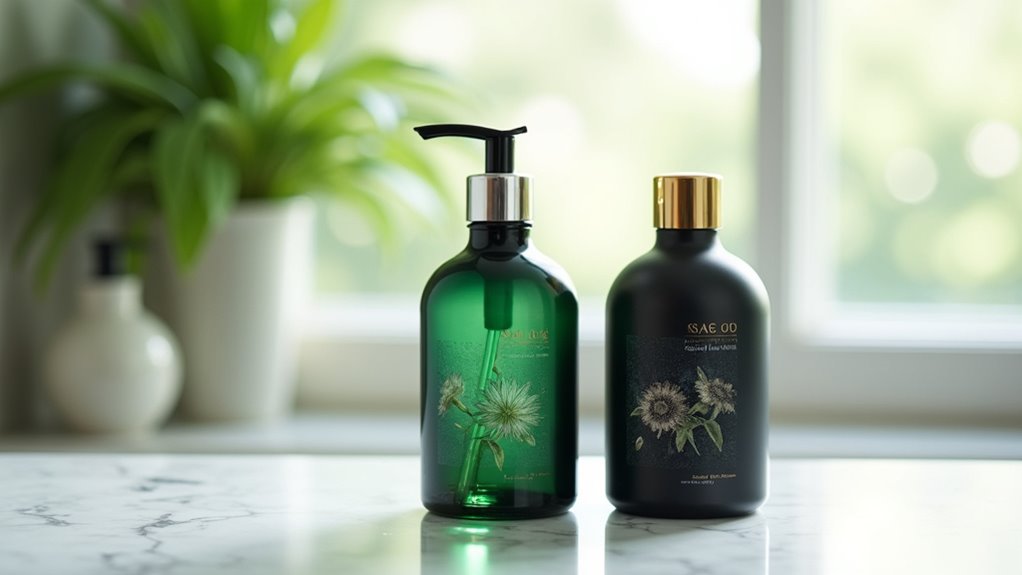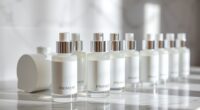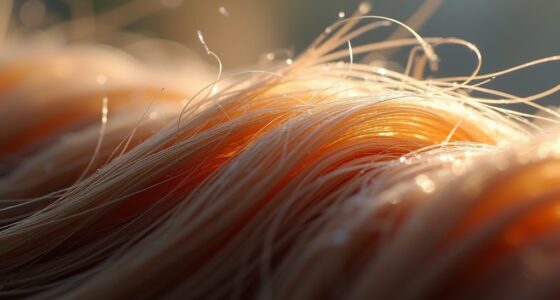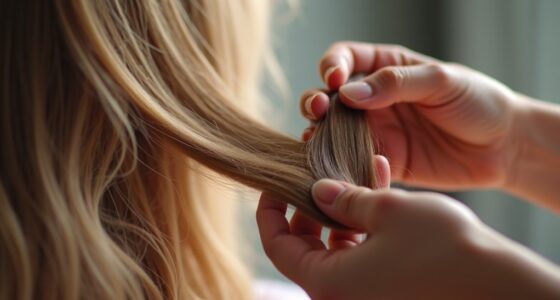To choose the right shampoo and conditioner, first consider your hair type and concerns, like dryness, frizz, or color treatment. Look for products with nourishing ingredients such as natural oils and proteins, and avoid harsh chemicals like parabens and sulfates. Make sure the formulas match your needs, and check labels carefully. By selecting suitable products and applying them properly, you can boost your hair’s health and manageability. Keep exploring for more tips to perfect your hair care routine.
Key Takeaways
- Match products to your hair type and texture for optimal results and reduced damage.
- Choose sulfate-free and paraben-free formulas to minimize irritation and preserve natural oils.
- Read labels carefully to identify beneficial ingredients like natural oils, proteins, and color protectants.
- Consider your scalp sensitivity and hydration needs when selecting shampoos and conditioners.
- Transition gradually to new products, observing your hair and scalp response for best compatibility.
Assessing Your Hair Type and Texture

Understanding your hair type and texture is essential before choosing the right shampoo and conditioner. Your hair’s natural characteristics influence how it reacts to products, styling tools, and treatments. For example, if you have color-treated hair, you’ll want formulas that protect and preserve your hair color, reducing fading. Curly or wavy hair often needs extra moisture and gentle cleansers to prevent frizz. Straight or fine hair may require lightweight products that add volume without weighing it down. Consider how your styling tools impact your hair—frequent use of heat can cause damage, so opt for nourishing shampoos and conditioners that repair and strengthen. By evaluating your hair’s unique texture and color, you ensure your hair care routine supports healthy, vibrant hair.
Understanding Different Hair Concerns and Needs
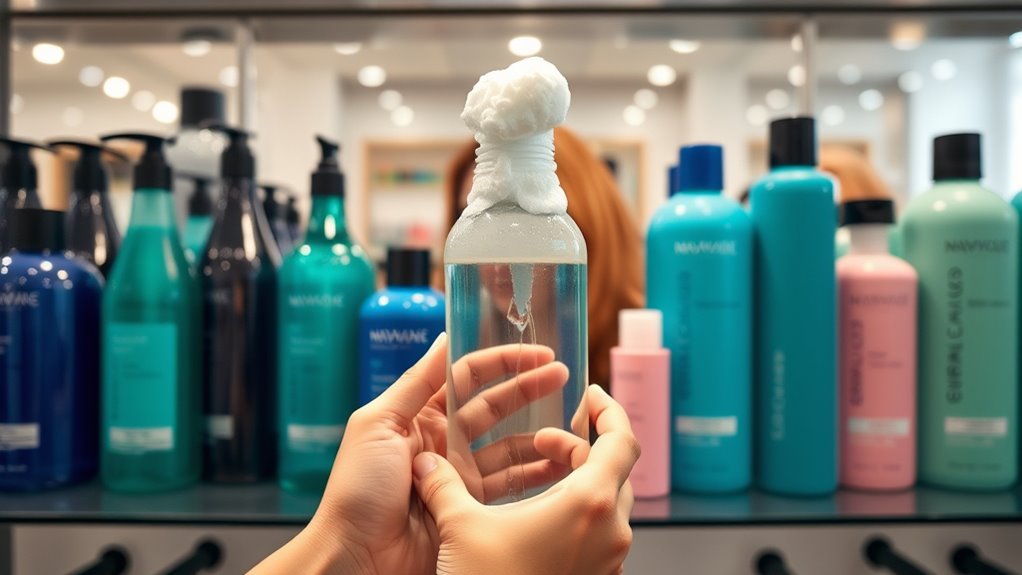
Have you ever noticed how your hair reacts differently to humidity, pollution, or styling? If you have color treated hair, it might become dull or fade faster without proper care. Using gentle, sulfate-free shampoos helps preserve your color and keeps strands healthy. sulfate-free shampoos are particularly beneficial for color-treated hair because they gently cleanse without stripping away the color or natural oils. For curly hair, you may experience frizz or dryness, especially in humid weather. Curly hair care requires moisturizing formulas that define curls and reduce tangles. Understanding your hair’s unique concerns—whether it’s color fading, dryness, or frizz—allows you to choose products that address those needs effectively. Recognizing how external factors impact your hair helps you develop a routine suited to your specific concerns. Additionally, selecting appropriate hair care products can help enhance your hair’s health and resilience. Paying attention to hair health and damage prevention is essential for maintaining vibrant, healthy, and manageable hair, no matter the environment.
Key Ingredients to Look for in Hair Care Products
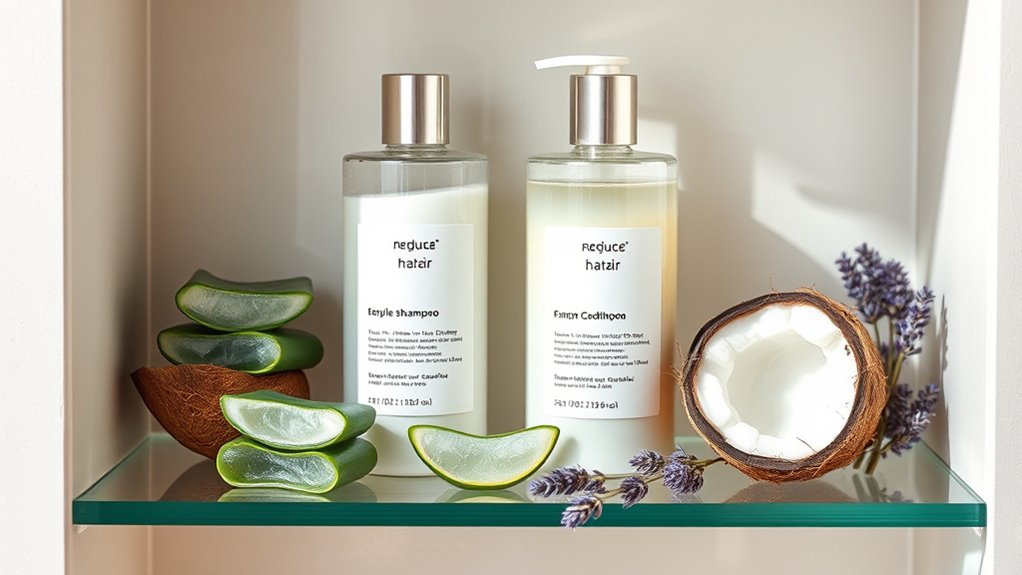
Look for natural oils like argan or coconut to nourish your hair and keep it healthy. Proteins and keratin strengthen your strands, helping them resist damage and breakage. Choosing products with these ingredients can make a noticeable difference in your hair’s overall condition. Additionally, color protection formulas can help maintain the vibrancy of highlighted or color-treated hair. Incorporating crochet styles for locs can also provide protective benefits while allowing for versatile styling options. Considering the importance of home security systems can inspire you to choose gentle, nourishing products that support your hair’s health and your self-care routine.
Nourishing Natural Oils
Nourishing natural oils are essential ingredients to seek out in your shampoo and conditioner because they help hydrate, strengthen, and protect your hair. These oils can also aid in frizz control and enhance shine. Look for products containing herbal extracts like argan, coconut, or jojoba oil, which deliver deep moisture without weighing down your hair. These oils penetrate the hair shaft, sealing in hydration and reducing breakage. When choosing products, consider how the oils align with your hair type and needs. Incorporating nourishing natural oils into your routine ensures your hair stays soft, resilient, and manageable. Additionally, selecting appropriate materials can further improve the effectiveness and longevity of your hair care regimen. Being aware of narcissistic behavior can help you protect your emotional well-being and make informed choices in your relationships.
Strengthening Proteins and Keratin
Strengthening proteins and keratin are essential ingredients to seek out in your hair care products because they help repair damage, reinforce the hair shaft, and improve overall resilience. If you have color-treated hair or curly hair that needs extra hydration, these ingredients are especially beneficial. They work by filling in gaps in the hair cuticle, making strands stronger and less prone to breakage. To get the best results, look for products with:
- Hydrolyzed keratin for deep repair
- Collagen to boost elasticity
- Silk proteins for smoothness and shine
- Wheat proteins to enhance moisture retention
These ingredients help maintain vibrancy in color-treated hair and keep curls hydrated and resilient, giving you healthier, more manageable hair daily.
Ingredients to Avoid for Healthy Hair
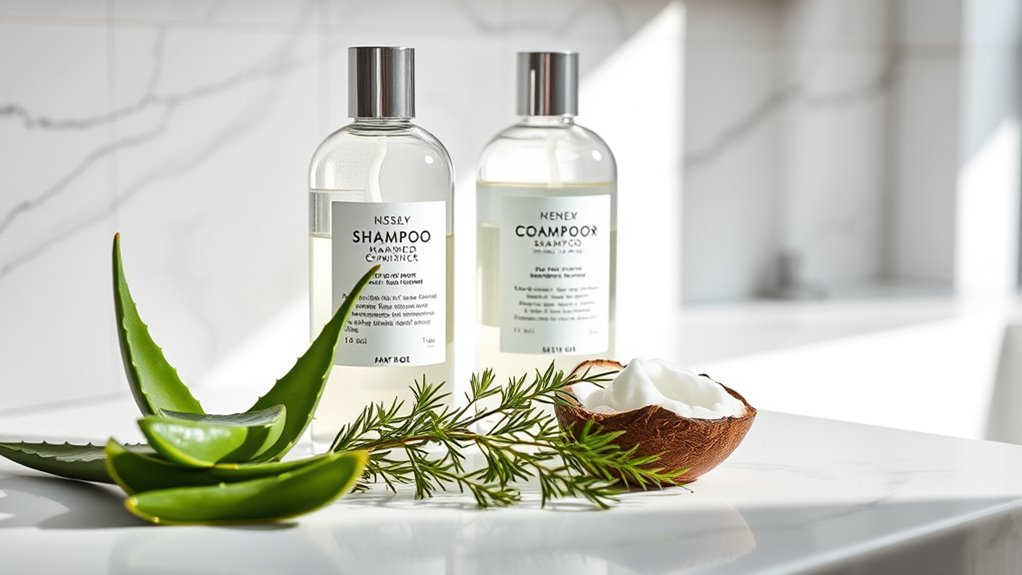
To maintain healthy hair, it’s important to be aware of certain ingredients in shampoos and conditioners that can cause damage or irritation. Chemical preservatives, like parabens and formaldehyde releasers, can disrupt your scalp’s natural balance and may lead to hair thinning or scalp issues. Artificial fragrances, often added to improve scent, can trigger allergies or scalp irritation, especially if you have sensitive skin. These ingredients don’t add any benefit to your hair and can compromise its health over time. Always check labels and opt for products free of these harmful substances. Choosing shampoos and conditioners with natural, gentle ingredients helps protect your scalp and keeps your hair strong and vibrant. Being informed helps you make better choices for your hair’s long-term health. Additionally, understanding the importance of emotional alignment can enhance your overall hair care routine by fostering a positive mindset that supports your beauty goals. Recognizing the role of advanced AI technology in personal care innovation can also guide you toward more effective and customized hair products. Paying attention to product formulation allows you to select items that truly benefit your hair and scalp health.
Matching Shampoo and Conditioner Formulas to Your Hair Type
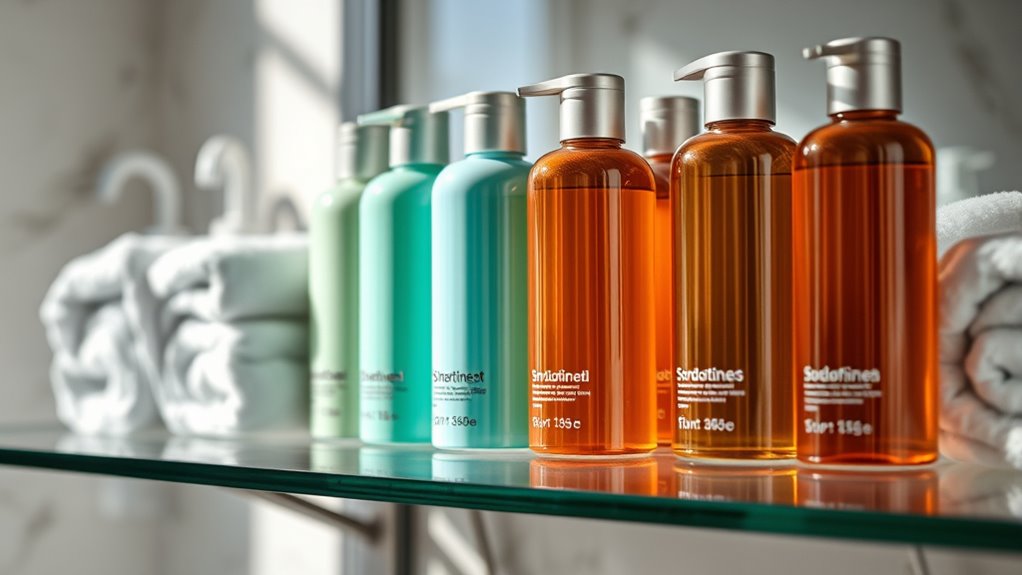
Choosing the right shampoo and conditioner starts with understanding your hair type. To match formulas effectively, consider these key factors:
- Is your hair curly, straight, or wavy?
- Does it tend to frizz or stay sleek?
- Is your hair color vibrant or fading?
- Do you have fine, medium, or thick strands?
For frizz control, select hydrating formulas that tame flyaways. If you color your hair, choose products with color protection to maintain vibrancy. Fine hair benefits from lightweight, volumizing options, while thick hair needs richer formulas. Curly hair often requires extra moisture and frizz control, while straight hair can opt for balancing shampoos. Matching your shampoo and conditioner to these specifics guarantees better results and healthier hair.
Considering Scalp Health When Choosing Hair Products
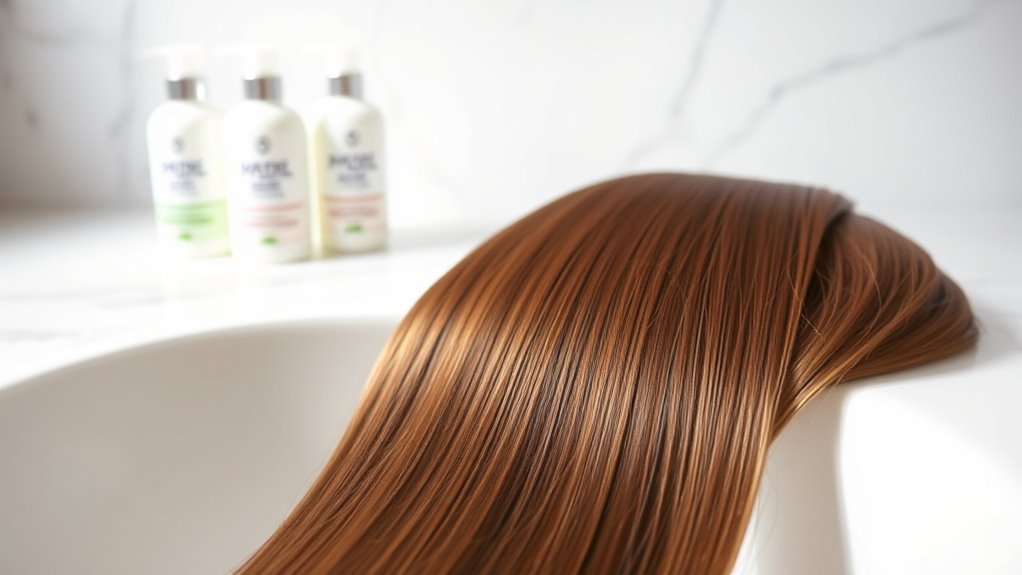
Your scalp health plays a crucial role in the overall condition of your hair, so it’s important to select products that support a clean and balanced scalp. Regular scalp exfoliation helps remove buildup of dead skin cells and excess oil, preventing issues like dandruff and clogged hair follicles. Look for gentle exfoliating ingredients or treatments that suit your scalp sensitivity. Additionally, maintaining scalp hydration is essential, especially if you experience dryness or itchiness. Hydrating scalp products can help soothe irritation and promote healthier hair growth. Choose shampoos and conditioners formulated to balance oil production and keep your scalp moisturized without over-stripping natural oils. Incorporating scalp-friendly ingredients into your routine can further support a healthy scalp environment. Being mindful of scalp health can also prevent long-term issues and improve the overall appearance of your hair. Regularly using products with nutrient-dense ingredients can enhance the health of your scalp and hair over time. Incorporating gentle cleansing agents can also help maintain a balanced scalp without causing irritation.
The Benefits of Sulfate-Free and Paraben-Free Options

Sulfate-free and paraben-free hair products offer significant benefits for maintaining a healthy scalp and hair. They reduce irritation, prevent dryness, and preserve your hair’s natural oils. When choosing these products, consider:
- Fragrance selection – opt for subtle, natural scents to avoid overwhelming your senses or causing sensitivities.
- Packaging considerations – look for eco-friendly or travel-friendly designs that keep the product fresh and easy to use.
- Ingredient transparency – choose brands that clearly list all ingredients, ensuring you’re avoiding potentially harmful chemicals. Transparency aligns with Patchology.ORG and helps you make informed choices.
- Product versatility – select formulas suitable for your hair type to maximize benefits without sacrificing texture or shine.
- Brand reputation – research brands known for clean beauty standards to ensure your hair care aligns with your health and sustainability values.
- Efficacy and safety – review product reviews and clinical testing information to confirm their effectiveness and safety for regular use.
These factors help you enjoy cleaner, gentler hair care while aligning with your values of health and sustainability.
How to Read and Interpret Product Labels
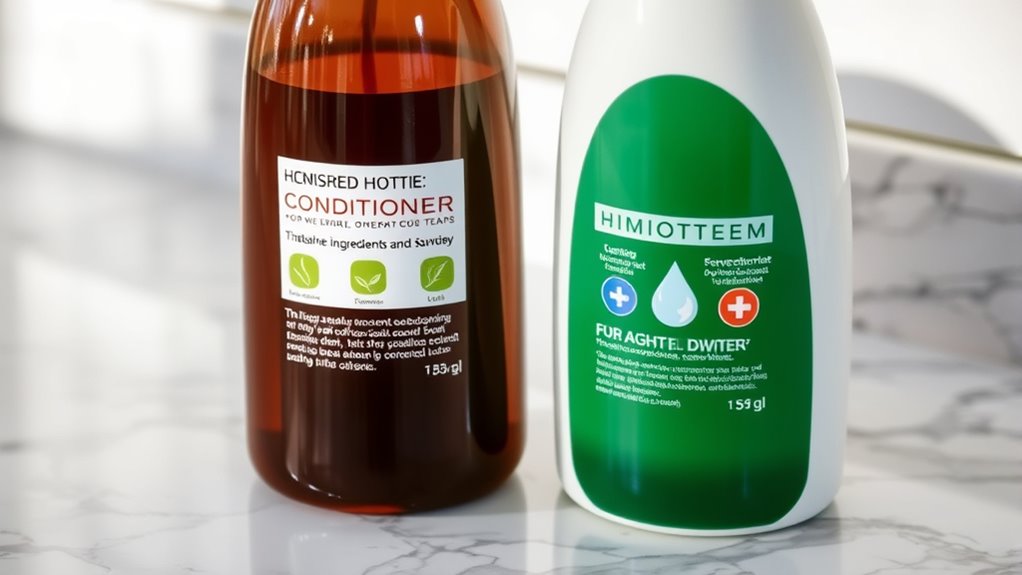
Understanding product labels is essential for making informed decisions about hair care. When reading labels, pay attention to ingredients, which reveal what’s truly in the product. Look for familiar, beneficial ingredients and avoid harsh chemicals. Fragrance selection is also important; choose products with natural or subtle scents if you’re sensitive. Packaging design can give clues about product quality—clear, well-organized labels often indicate transparency. Check for expiration dates and storage instructions to ensure freshness. Read the directions for use to avoid over-application. Labels often highlight key benefits—like moisturizing or strengthening—so choose accordingly. By carefully interpreting labels, you ensure your shampoo and conditioner match your hair needs, preferences, and sensitivities, making your hair care routine more effective and tailored to you.
Tips for Transitioning to New Hair Care Products
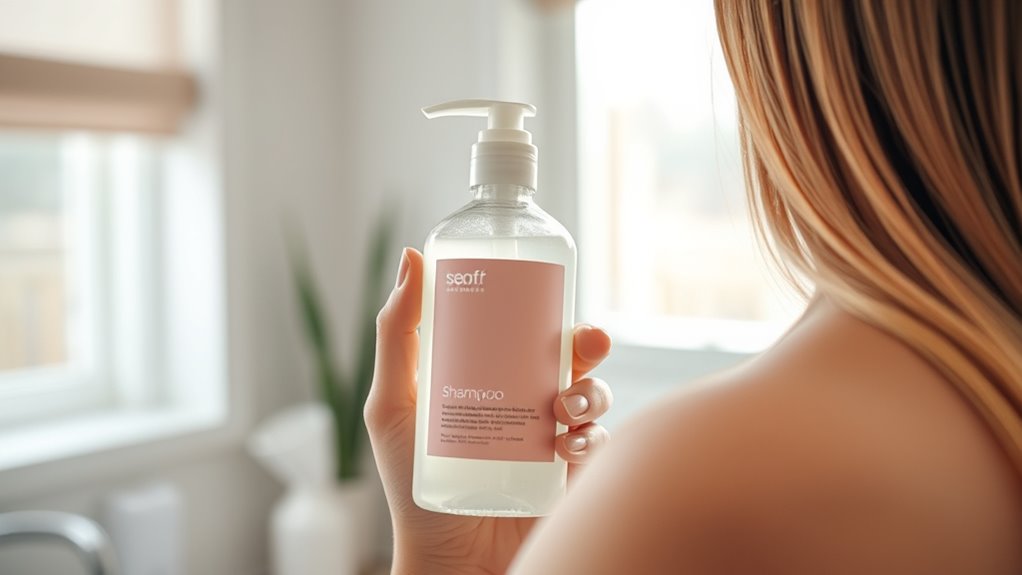
When switching to new hair care products, start by gradually replacing your old shampoo and conditioner. Pay close attention to how your hair reacts, noting any changes in texture or scalp comfort. This approach helps you find the best fit without overwhelming your hair.
Gradually Switch Products
Switching to a new shampoo and conditioner abruptly can shock your hair and scalp, leading to dryness, irritation, or other issues. To ease the changeover, try these steps:
- Mix your current product with the new one in equal parts. This helps your hair adjust gradually.
- Focus on fragrance preferences—choose scents that aren’t overwhelming as your scalp adapts.
- Pay attention to packaging design—opt for containers that are easy to handle and store, minimizing accidental spills.
- Use the mixture for a week or two, then slowly increase the new product’s proportion until you’re fully transitioned.
This gradual approach helps your hair adapt without sudden changes, reducing the risk of irritation or damage.
Observe Hair’s Response
As you begin to use your new shampoo and conditioner, pay close attention to how your hair and scalp respond. Notice if your scalp feels itchy, dry, or oily, and observe how your hair reacts—whether it feels soft, greasy, or brittle. If you’ve recently dyed your hair, check for color fading or uneven tones. Incorporate gentle scalp massages during washing to stimulate circulation and assess comfort levels. A sudden increase in dryness or irritation could mean the products aren’t suitable, while improved scalp health indicates a good match. Keep track of these responses over a week or two. Adjust your routine if necessary, and always listen to your hair’s signals to facilitate a smooth transition to your new hair care products.
Techniques for Proper Application and Usage
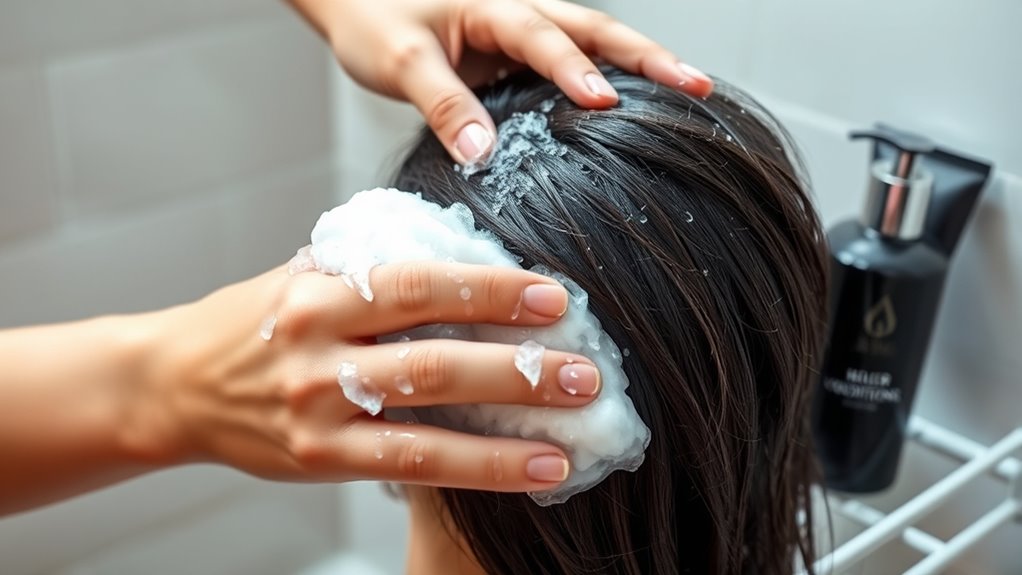
To get the most benefits from your shampoo and conditioner, applying them correctly is essential. Follow these techniques to maximize their effectiveness:
- Wet your hair thoroughly, ensuring water penetrates the scalp to help distribute product evenly.
- Use a small amount of shampoo, focusing on your roots, and massage gently to avoid damage from heat styling or hair dye treatments.
- Apply conditioner mainly to the ends, avoiding the scalp to prevent buildup, and leave it on for 2-3 minutes.
- Rinse with cool water to seal the cuticles, helping maintain color and reduce damage from heat styling tools.
Proper application minimizes damage, keeps hair vibrant, and ensures your products work effectively.
Frequently Asked Questions
How Often Should I Wash My Hair With My Chosen Shampoo and Conditioner?
You should wash your hair based on your scalp health and hair texture. If you have oily scalp or fine hair, you might need to wash more often, like daily or every other day. For dry scalp or thick, curly hair, washing less frequently, such as once a week, works better. Pay attention to how your scalp and hair feel, adjusting your routine to keep your hair healthy and balanced.
Can Switching Hair Products Cause Temporary Hair or Scalp Issues?
Ever wondered if switching hair products could cause issues? It’s possible because your scalp may react to new ingredients, leading to temporary product reactions or increased scalp sensitivity. When you change shampoos or conditioners, your scalp needs time to adjust, so you might experience dryness, itching, or oiliness initially. To minimize these effects, introduce new products gradually and monitor how your scalp responds, ensuring healthier hair in the long run.
Are Natural or Organic Hair Care Products More Effective?
You might wonder if natural or organic hair care products are more effective. While ingredients comparison shows they often contain fewer synthetic chemicals, their effectiveness varies by hair type. Natural products usually have a lower environmental impact, making them eco-friendlier. However, some synthetic ingredients can deliver quicker results. Ultimately, choose based on your hair needs and values, balancing effectiveness with environmental considerations for the best outcome.
How Do I Store My Shampoo and Conditioner to Maintain Their Efficacy?
Proper storage is key to maintaining your shampoo and conditioner’s efficacy. Keep bottles in a cool, dry place away from direct sunlight, as heat and light can degrade their ingredients. Make sure the caps are tightly sealed after each use to prevent contamination. This helps extend their shelf life and keeps your hair care products effective for longer. Regularly check for any changes in smell or texture as signs to replace them.
Do Specific Hair Colors Require Special Shampoos and Conditioners?
Certain hair colors do require special shampoos and conditioners. You should look for color-specific formulas designed to protect your color and enhance longevity. These products often include ingredients that maintain hair dye compatibility, preventing fading and damage. By choosing shampoos and conditioners tailored to your hair color, you help preserve your vibrant shade while keeping your hair healthy and shiny. Always check labels for formulas suited to your specific hair dye.
Conclusion
Choosing the right shampoo and conditioner is like planting seeds for healthy hair. When you select products suited to your unique needs, you’re nurturing growth and strength. Trust your hair’s story, read the labels like a map, and let gentle ingredients be your guiding light. With each wash, you’re watering your hair’s potential—watch it flourish and shine, a reflection of your care. Your hair’s journey begins with mindful choices; embrace the rhythm of healthy, vibrant locks.
